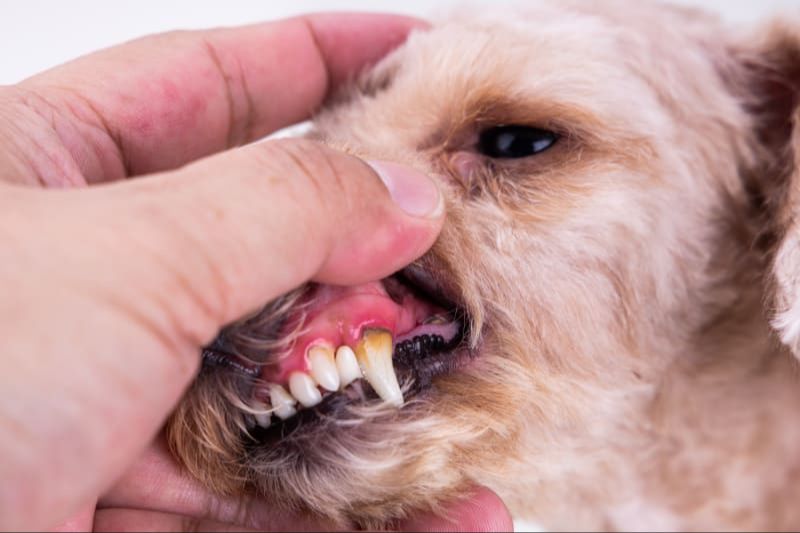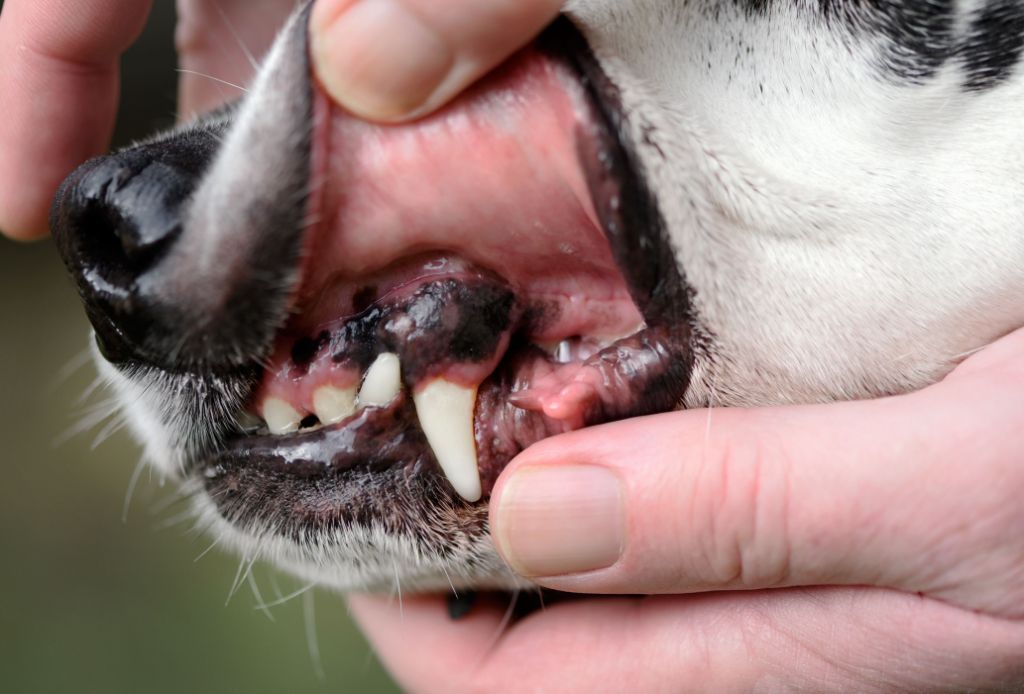Introduction
Gum color is an important indicator of your dog’s overall health. By being aware of your dog’s normal gum color and monitoring for any changes, you can catch potential health issues early. This guide will define what normal gum color looks like in dogs, explain why monitoring gum color is important, and outline what gum colors may indicate about your dog’s health.
We’ll cover the anatomy of a dog’s gums, go over what different gum colors signify, explain when you should take your dog to the vet, and provide tips on keeping your dog’s gums healthy. With this guide, you’ll understand what normal dog gum color looks like and how to monitor your dog’s gums for signs of potential problems.
Anatomy of a Dog’s Gums
A dog’s gums contain multiple layers of tissue, including the outer epithelial tissue, connective tissue, muscles, and the periodontal ligament. The epithelial tissue is the protective outer layer that covers the gums. Underneath is connective tissue that provides structure. The gums also contain muscle fibers that allow flexibility and motion.
A key component of a dog’s gums are the capillaries, which are tiny blood vessels located near the surface. The capillaries bring blood containing oxygen and nutrients to the gums and also help remove waste. Due to their proximity to the surface, the amount of blood flowing through the capillaries determines the color of the gums.
Importance of Healthy Gums
A dog’s gums play a vital role in their overall oral health. Healthy gums help protect the teeth and prevent periodontal disease. The gums surround the teeth and provide a tight seal that acts as a barrier against bacteria invading the tooth sockets and jawbone.
If the gums become inflamed or damaged, this protective barrier is broken. Bacteria can then penetrate deeply around the tooth roots and cause periodontal disease. Periodontal disease is a serious infection that damages the soft tissue and bone supporting the teeth. Left untreated, it can lead to painful tooth loss.
Checking your dog’s gums regularly allows you to spot early warning signs of gum inflammation or periodontal disease. Healthy gums should be firm and pink, not swollen or red. Make sure to inspect your dog’s gums at least weekly as part of their oral care routine. Gently lift their lips to examine the gums around each tooth.
Along with brushing your dog’s teeth, keeping their gums healthy helps prevent plaque buildup and tartar formation. Good oral hygiene reduces their risk for developing gum infections or advanced dental disease.
Normal Gum Color

The ideal gum color for a healthy dog is pink. A nice bubblegum or salmon pink indicates good blood flow and healthy gums. The gums should also look moist and shiny.
There can be some natural variation in gum color depending on the breed. For example, some dogs naturally have black pigmented gums rather than pink. This pigmentation is normal for breeds like Chows and Shar Peis. Greyhounds also tend to have darker grayish gums.
While the exact shade may vary, a dog’s gums should always appear moist and well perfused. Pale, white, blue or very dark gums can be an indicator of a medical issue.
Pale Gums
One of the most common gum color changes in dogs is pale gums. There are a few potential causes for this:
Anemia: Anemia refers to a lower than normal red blood cell count or hemoglobin levels in the blood. It can make your dog’s gums appear pale or white. Anemia may be caused by blood loss, low iron intake, immune-mediated disease, infections like parvo virus, or cancers like leukemia. Treatment depends on the underlying cause but may include supplements, diet changes, medications, or transfusions.
Low blood pressure: Dogs with abnormally low blood pressure, known as hypotension, may also have pale looking gums. Some common causes include dehydration, heart conditions, sepsis, pain, blood loss, and certain medications. Treating hypotension usually involves intravenous fluids and medications.
Shock: Shock is a life-threatening condition where blood flow is insufficient to supply enough oxygen to organs and tissues. One sign is pale or white gums. Shock requires rapid treatment like IV fluids, oxygen therapy, and medication.
If your dog’s gums are paler than usual, it’s important to see your vet as soon as possible. They can run tests to determine the cause and start appropriate treatment. Make sure your dog stays warm and limit activity. With prompt care, many dogs recover fully from conditions leading to pale gums.
Bright Red Gums
Bright red gums in dogs can be a sign of inflammation or infection. When a dog’s gums are redder or pinker than their normal color, it often indicates an increased blood flow to the area, which can happen due to irritation, injury, or disease. Some potential causes for bright red gums in dogs include:
- Gingivitis – inflammation of the gums, often caused by tartar buildup and plaque on the teeth. Gingivitis will cause the gums to look puffy, inflamed and overly bright red.
- Periodontitis – advanced gum infection that damages tissue and bone. The gums will look very red, inflamed and may bleed easily.
- Abscessed tooth – a tooth abscess can cause inflammation of surrounding gum tissue, making the gums appear bright red around that tooth.
- Foreign object – a splinter, thorn or other foreign object stuck in the gums can cause localized bright redness and inflammation.
- Cancer – gum cancer or melanoma, while rare, can also lead to overly red and inflamed gums.
If your dog’s gums appear persistently or overly bright red with no known cause, it’s important to have your vet examine them. Treatment will depend on the underlying condition. For gingivitis and periodontal disease, a professional dental cleaning and antibiotics may be needed to control the infection. Abscessed teeth may require extraction. Cancerous growths also need to be treated as soon as possible.

Keeping your dog’s teeth clean through regular brushing and dental checkups is the best way to prevent gum inflammation and infections. Let your vet know right away if you notice any abnormal gum redness that does not resolve within a day or two.
Blue, Purple, or White Gums
If your dog’s gums appear blue, purple, or white in color, this condition is known as cyanosis and indicates a serious health issue. Cyanosis occurs when blood has a difficult time getting oxygenated. As a result, the blood carries less oxygen to body tissues, causing the gums to take on a bluish tint.
There are several potential causes of cyanotic gums in dogs:
- Choking or obstruction of the airways – If your dog is choking on something lodged in their throat or windpipe, they will be unable to breathe properly. This leads to a lack of oxygen circulating in the blood, resulting in cyanosis.
- Heart problems – Some heart conditions like congenital heart defects or pulmonary hypertension can prevent blood from getting properly oxygenated. This will cause cyanosis of the gums and tongue.
- Respiratory diseases – Problems like pneumonia, fluid in the lungs, or a collapsed trachea make it difficult for your dog to breathe and get enough oxygen. Their gums may turn blue or purple as a result.
- Toxins or poisons – Exposure to certain toxins can impact the blood’s ability to carry oxygen. This includes things like antifreeze, lead, zinc, or heavy metals.
If your dog’s gums appear blue, purple, white, or gray, it is considered a medical emergency. Cyanosis indicates a critical lack of oxygen that needs veterinary intervention right away. Without treatment, cyanosis can quickly lead to loss of consciousness, organ damage, and possibly death. Call your vet immediately if you notice these abnormal gum colors in your dog.
Spotted or Patchy Gums

Sometimes a dog’s gums may appear mottled or spotted in certain areas. This can indicate an underlying health issue that needs veterinary attention. Potential causes for spotted or patchy gums include:
- Plaque buildup – If tartar and plaque accumulates on the teeth and gums, it can cause gum inflammation and discoloration in localized areas. Plaque buildup needs to be addressed through regular teeth cleaning.
- Melanoma – Dark colored splotches on the gums may potentially indicate the presence of melanoma. Oral melanoma is an aggressive cancer in dogs that warrants rapid diagnosis and treatment.
- Immune disorders – Autoimmune diseases can sometimes manifest with spotty gums. Pemphigus and other immune conditions can cause pustules and inflammation on the gums.
- Injury or trauma – Physical damage to the gums from a foreign object, cut, or scratch may result in discolored patches as the area heals.
If your dog’s gums appear mottled, take him to the veterinarian for an exam. The vet can help determine the underlying cause and recommend appropriate treatment. Plaque and tartar buildup is very common and can be addressed through regular dental cleanings. More serious conditions like melanoma will require biopsy, surgery, chemotherapy or radiation. With prompt veterinary care, many causes of gum discoloration can be managed for improved health and comfort.
When to See the Vet
While healthy dog gums are moist and pink, some gum color changes can indicate an underlying medical issue requiring veterinary attention. Here are some abnormal gum colors and symptoms that warrant a trip to the vet:
Pale Gums
If your dog’s gums are paler pink or white, this can signal anemia or inadequate blood flow. Anemia is often caused by blood loss, destruction of red blood cells, or deficiencies in iron or vitamins needed to produce red blood cells. Seek prompt vet care if your dog’s gums are pale.
Bright Red Gums
Bright cherry red gums can indicate increased blood flow due to inflammation, infection, heat stroke, poisoning, or a high white blood cell count. Your vet can run tests to determine the cause and provide proper treatment.
Blue, Purple, or White Gums
Gums that are blue, purple, white, or grayish signal a lack of adequate oxygen in the blood and require emergency vet care. This can result from choking, heart issues, poisoning, shock, or hypothermia.
Spotted or Patchy Gums
Spotted, ulcerated, or patchy gums may result from gingivitis, autoimmune disease, fungal or viral infections, or cancer. Schedule a vet visit to diagnose and treat the underlying cause.
Caring for Your Dog’s Gums
There are a few simple things you can do at home to help keep your dog’s gums healthy:
- Brush your dog’s teeth regularly. This helps remove plaque and tartar that can cause gum disease. Use a soft dog toothbrush and dog toothpaste.
- Provide chew toys. Chewing helps exercise gums and scrape away bacteria. Good options include rope toys, rubber chew toys, and raw bones.
- Feed a high-quality diet. Choose dog food that will help control plaque and promote oral health.
- Schedule regular vet dental cleanings. Your vet can scale away tartar and check for signs of gum disease.
- Monitor gum color and health. Lift your dog’s lips regularly to check that the gums look moist and pink, not pale, inflamed, or discolored.
- Bring your dog for regular vet checkups. Your vet can examine your dog’s oral health and look for any issues.

Taking steps to care for your dog’s gums at home, in addition to professional cleanings, can help prevent gum disease and promote your dog’s overall health and wellbeing.
